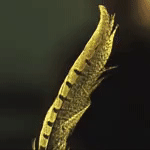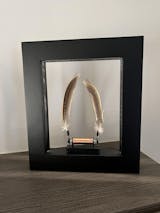Free Delivery On All Orders | 1-Year Limited Warranty
SLOW DANCE
by Jeff Lieberman

Slow Dance is a visual artwork created by Jeff Lieberman. By taking advantage of the limits of human visual perception, it makes real objects appear to move in slow motion. Perfect for the home, office or as a gift!
Ebonized Ash
Craft Pine
Light Pine
1 frame. 4 unique illusions.
The Slow Dance has different modes, that all display a different illusion.Switch easily between the modes and find your favorite!

Slow Dance
In this mode the object appears to move in slow motion.

Super Slow Dance
The objects appears to move in ultra slow motion.

Double Trouble
Looks like the object starts as one, and splits into two parts before reforming.

Pop and Lock
The object looks like it jumps through space, like a 1930s slow motion movie!

Using science to create magic
By using high speed strobe lights blinking 80 times a second, your eyes cannot even see that they are blinking - the light looks continuous.
By synchronizing the strobes to the high-speed vibration of objects (created with the magnets and central electromagnet), we create the visual illusion of those objects moving in slow motion. This is a phenomenon called persistence of vision, and works similarly to the way a TV works - by flickering frozen images quickly enough that we perceive them as continuous motion. By varying the timing of the strobelights, the different animations are created - but the actual motion is always the same.
Original Art by Jeff Lieberman
When my closest friend from college Eric was marrying my new friend Emily, I considered it the time to give them a once-in-a-lifetime gift. They were both dancers, and so I immediately thought about creating something where two ‘opposites’ danced with one another.
I had been playing for years with techniques that allowed me to use high-speed stroboscopy to make things look like they were moving in slow motion. But after weeks of hand-designing dozens of objects that might vibrate in interesting ways, I was stuck — none of them had the wondrous impact I was searching for. Somehow they didn’t surprise me enough as a viewer to create impact. I went for a frustrated walk around the block of my office thinking “What is missing? Why can’t I design something that looks incredible to see moving in slow motion?” Lost in thought, a branch hit me in the face. I looked at the branch.
It was a Eureka moment. That pine branch was more beautiful than anything I as a person could design, and had evolved over millions of years to vibrate in the wind. I looked all around the environment — branches, flowers, feathers and more — with a sense of awe suddenly realizing that nature had designed millions of artifacts more beautiful than I ever would. And using what I knew, I could make them look like they were dancing impossibly, in slow motion.

1 frame. 4 unique illusions.
The Slow Dance has different modes, that all display a different illusion.
Switch easily between the modes and find your favorite!

Slow Dance
In this mode the object appears to move in slow motion.

Super Slow Dance
The objects appears to move in ultra slow motion.

Double Trouble
Looks like the object starts as one, and splits into two parts before reforming.

Pop and Lock
The object looks like it jumps through space, like a 1930s slow motion movie!
Using science to create magic

By using high speed strobe lights blinking 80 times a second, your eyes cannot even see that they are blinking - the light looks continuous.
By synchronizing the strobes to the high-speed vibration of objects (created with the magnets and central electromagnet), we create the visual illusion of those objects moving in slow motion. This is a phenomenon called persistence of vision, and works similarly to the way a TV works - by flickering frozen images quickly enough that we perceive them as continuous motion.By varying the timing of the strobelights, the different animations are created - but the actual motion is always the same.
Original art by Jeff Lieberman

When my closest friend from college Eric was marrying my new friend Emily, I considered it the time to give them a once-in-a-lifetime gift. They were both dancers, and so I immediately thought about creating something where two ‘opposites’ danced with one another.
I had been playing for years with techniques that allowed me to use high-speed stroboscopy to make things look like they were moving in slow motion. But after weeks of hand-designing dozens of objects that might vibrate in interesting ways, I was stuck — none of them had the wondrous impact I was searching for.
Somehow they didn’t surprise me enough as a viewer to create impact. I went for a frustrated walk around the block of my office thinking “What is missing? Why can’t I design something that looks incredible to see moving in slow motion?” Lost in thought, a branch hit me in the face. I looked at the branch.
It was a Eureka moment. That pine branch was more beautiful than anything I as a person could design, and had evolved over millions of years to vibrate in the wind. I looked all around the environment — branches, flowers, feathers and more — with a sense of awe suddenly realizing that nature had designed millions of artifacts more beautiful than I ever would. And using what I knew, I could make them look like they were dancing impossibly, in slow motion.




